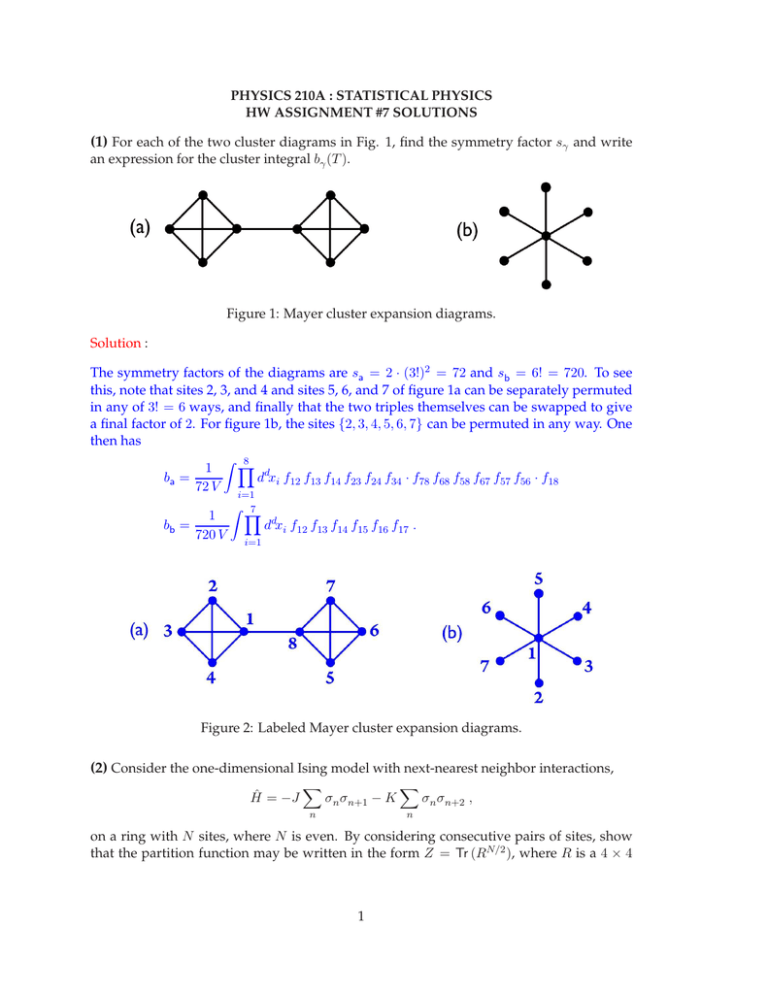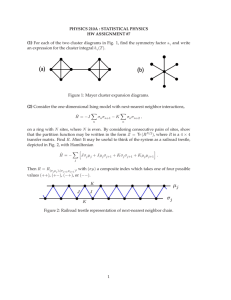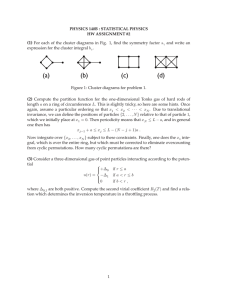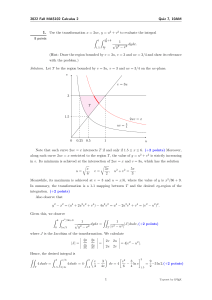(1)
advertisement

PHYSICS 210A : STATISTICAL PHYSICS
HW ASSIGNMENT #7 SOLUTIONS
(1) For each of the two cluster diagrams in Fig. 1, find the symmetry factor sγ and write
an expression for the cluster integral bγ (T ).
Figure 1: Mayer cluster expansion diagrams.
Solution :
The symmetry factors of the diagrams are sa = 2 · (3!)2 = 72 and sb = 6! = 720. To see
this, note that sites 2, 3, and 4 and sites 5, 6, and 7 of figure 1a can be separately permuted
in any of 3! = 6 ways, and finally that the two triples themselves can be swapped to give
a final factor of 2. For figure 1b, the sites {2, 3, 4, 5, 6, 7} can be permuted in any way. One
then has
Z Y
8
1
ddxi f12 f13 f14 f23 f24 f34 · f78 f68 f58 f67 f57 f56 · f18
ba =
72 V
i=1
Z Y
7
1
bb =
ddxi f12 f13 f14 f15 f16 f17 .
720 V
i=1
Figure 2: Labeled Mayer cluster expansion diagrams.
(2) Consider the one-dimensional Ising model with next-nearest neighbor interactions,
Ĥ = −J
X
σn σn+1 − K
n
X
σn σn+2 ,
n
on a ring with N sites, where N is even. By considering consecutive pairs of sites, show
that the partition function may be written in the form Z = Tr (RN/2 ), where R is a 4 × 4
1
transfer matrix. Find R. Hint: It may be useful to think of the system as a railroad trestle,
depicted in Fig. 2, with Hamiltonian
i
Xh
Ĥ = −
Jσj µj + Jµj σj+1 + Kσj σj+1 + Kµj µj+1 .
j
Then R = R(σ
j µj ),(σj+1 µj+1 )
, with (σµ) a composite index which takes one of four possible
values (++), (+−), (−+), or (−−).
Figure 3: Railroad trestle representation of next-nearest neighbor chain.
Solution :
The transfer matrix can be read off from the Hamiltonian:
′
′
′
R(σµ),(σ′ µ′ ) = eβJµ(σ+σ ) eβK(σσ +µµ ) .
Expressed as a matrix of rank four, with rows and columns corresponding to {++, +−, −+, −−},
we have
2β(J+K)
e
e2βJ
1
e−2βK
e−2βJ
e−2β(J−K)
e−2βK
1
.
R=
−2βK
−2β(J−K)
−2βJ
1
e
e
e
e−2βK
1
e2βJ
e2β(J+K)
Querying WolframAlpha for the eigenvalues, we find
i
h
p
λ1 = 21 uv − (1 + u−1 ) u2 v 2 − 2uv 2 + 4u + v 2 + 2v −1 + u−1 v
i
h
p
λ2 = 21 uv + (1 + u−1 ) u2 v 2 − 2uv 2 + 4u + v 2 + 2v −1 + u−1 v
h
i
p
λ3 = 21 uv − (1 − u−1 ) u2 v 2 + 2uv 2 − 4u + v 2 − 2v −1 + u−1 v
i
h
p
λ4 = 21 uv + (1 − u−1 ) u2 v 2 + 2uv 2 − 4u + v 2 − 2v −1 + u−1 v ,
where u = e2βJ and v = e2βK . The partition function on a ring of N sites, with N even, is
N/2
N/2
N/2
N/2
Z = Tr RN/2 = λ1 + λ2 + λ3 + λ4 .
2







